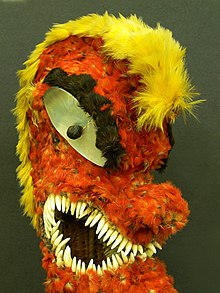Hawaiian art
Polynesians arrived there one to two thousand years ago, and in 1778 Captain James Cook and his crew became the first Europeans to visit Hawaii (which they called the Sandwich Islands).
This early art practice includes wood carvings, petroglyphs, kākau (Hawaiian tattooing), kapa (barkcloth; called kapa in Hawaiian, and tapa elsewhere in the Pacific), kapa kilohana (decorated barkcloth), ipu pā wehe (decorated gourds), kāhili (featherwork), lauhala weaving (weaving, plait, or braiding leaves), and leiomano (shark-tooth weapon).
A few craftsmen still produce traditional Hawaiian arts, either to sell to tourists or to preserve native culture.
These artists sketched and painted Hawaii’s people and landscapes using imported materials and concepts.
Artists in this category include: Artworks produced by Hawaii’s native born and long-term residents incorporating western materials and ideas include paintings on canvas and quilts.


